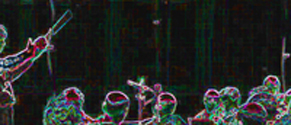
|
As has become a feature in many of the composer's works, Triptych for String Orchestra sets up three contrasting musical tableaux in as many different genres. Though this approach is often called post-modern, Korneitchouk prefers to see it as an indulgence of the many types of music he enjoys.

|
The work opens with a free form improvisatory movement, Chroma, whose sour romanticism comes from its rich chromatic palette. After a brief elegiac opening, overlapping organic "filaments" pass through the string orchestra, alternately building in contrapuntal intensity and then backing off, until the work reaches its first climax midway. A descending pattern then leads into an ostinato in the low strings. This new element, plus the original material, ebbs and flows in the moody second half of the movement, and resolves in a jittery flourish that hints nervously back at the elegiac opening.
|
|
|
The second movement, The Academy, is in many ways the opposite of the first. It is a very tightly constrained serial work where the parameters of rhythm, inflection, and dynamics, not just pitch, get a full serial workout of permutations. This might indicate to many a kind of mechanical device whereby the composer winds-up the machine and sets it loose. This is, for many, the typical criticism of such post-serial, super-regulated compositional process, that it is nothing more than a color-by-number process without life or purpose once left to run its course. But that is a rather simplistic view of compositional discipline and procedure. Actually, the composer aims at a much larger pay-off by establishing not just the on-set of the process, the opening canonic entries, already in stretto, notes like jet pilots splitting off from formation, but also its development and end point - the resolution that inexorably brings that canonic procedure applied to a theme and its inversion, ratcheted-up one intervalic step at a time, from the unison ultimately to the conclusion where the piece naturally assumes full major triadic resolution.
|
Rock, the third and "finale" movement, then can be seen as a happy medium between the two extremes of the previous movements. It's in the form of an episodic Dionysian romp that alternates between expositions of an ever more shrill theme with puckish episodes of varied quasi-ad lib solos embedded in coloristic texture. This classic 8-bar alternation concludes with a final exposition of the theme wrapped inside a large augmentation of itself.
|

